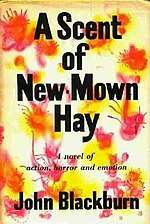John Blackburn (author)
| John Blackburn | |
|---|---|
 A Scent of New-Mown Hay cover art | |
| Born |
1923 Northumberland |
| Died | 1993 (aged 69–70) |
| Occupation | Bookseller |
| Nationality | British |
| Genre | Thrillers, horror, historical fiction |
John Fenwick Blackburn (born Northumberland, 26 June 1923; died 1993) was a British novelist who wrote thrillers, and horror novels. Blackburn was described as "today's Master of Horror" by The Times Literary Supplement.[1]
His horror novels are often structured as thrillers, with detective story plots involving international espionage, but often leading to either a supernatural or science fictional resolution.[2][3][4][5] This means that, as with some of the books of James Herbert, many of Blackburn's horror novels are notable for pace and plotting rather than for atmospheric effects. Blackburn specialised in mixing modern concerns such as germ warfare and international conspiracies with ancient traditions and curses, often to ingenious effect.[2] The Flame and the Wind (1967), by contrast, is an unusual historical novel set in Roman times, in which a nephew of Pontius Pilate tries to discover the facts about the crucifixion of Jesus.
Many of his books feature stock characters, including General Charles Kirk of British Intelligence and his friends, the scientist Sir Marcus Levin and his Russian wife Tania.[3]
Life
Blackburn was born in Corbridge, Northumberland and educated at Haileybury College and Durham University.[3] He was the brother of the poet Thomas Blackburn.[1] During the Second World War (1942–45) he served in the British merchant navy, becoming a radio officer. He attended Durham University after returning to civilian life, earning his bachelor's degree in 1949. In 1950 he married Joan Mary Clift. He was a schoolmaster in London for two years, and he taught in Berlin for a year, following which he returned to London and became a director of Red Lion Books.
Adaptations
Blackburn's novels Nothing But the Night and The Gaunt Woman were the basis for screenplays. The Gaunt Woman appeared as a made-for-TV movie in 1969 as Destiny of a Spy and Nothing But the Night was released to theaters in 1972.[6]A Scent of New-Mown Hay was also adapted as radio serial for BBC Radio 2 in 1969.[7]
Critical Reception
John Welcome in the Irish Times praised Blackburn's Blow The House Down as a "brilliant evocation of present-day stresses...more than a thriller, a contemporary novel and good one".[8] Blackburn's novel Bury Him Darkly was included by horror historian Robert S. Hadji in his list of "unjustly neglected" horror novels for Rod Serling's The Twilight Zone Magazine.[9] Frank Denton described Blackburn as "undoubtedly England's best practicing novelist in the tradition of the thriller/fantasy novel."[3] Hugh Lamb lauded Our Lady of Pain as "a tour de force version of the legend of the evil eye".[5] Don D'Ammassa described Bury Him Darkly as a "nicely crafted, often surprising, and definitely gripping thriller." [2] Howard Waldrop wrote an appreciation of Blackburn's novel A Scent of New-Mown Hay for the book Horror: Another 100 Best Books.[10]
Bibliography
Horror novels
- A Scent of New-Mown Hay (1958)
- A Sour Apple Tree (1958)
- Broken Boy (1959)
- A Ring of Roses (1965)
- Children of the Night (1966)
- Nothing But the Night (1968)
- Bury Him Darkly (1969)
- Blow the House Down (1970), a non-supernatural story in which a racist architect deliberately designs a building to be a death-trap [8]
- Devil Daddy (1972)
- For Fear of Little Men (1972)
- Our Lady of Pain (1974), based on Elizabeth Bathory, suggested by and dedicated to Christopher Lee
Thrillers
- Dead Man Running (1960)
- Bound to Kill (1963)
- The Winds of Midnight (1964)
- Murder at Midnight (1964)
- Packed for Murder (1964)
- The Reluctant Spy (1966)
- The Gaunt Woman (1967)
- Blue Octavo (1967)
- Colonel Bogus (1969)
- The Young Man from Lima (1970)
- The Household Traitors (1971)
- Deep Among the Dead Men (1973)
- Mister Brown's Bodies (1975)
- The Face of the Lion (1976)
- The Cyclops Goblet (1977)
- Dead Man's Handle (1978)
- The Sins of the Father (1979)
- A Beastly Business (1982)
- A Book of the Dead (1984)
- The Bad Penny (1985)
Historical novels
- The Flame and the Wind (1967)
New Publications
Valancourt Books began reprinting John Blackburn's works in 2013. In 2017 Centipede Press launched their program to re-issue Blackburn's most significant novels of weird fiction. Thus far, A Scent of New-Mown Hay, Bury Him Darkly have appeared, with Children of the Night and Devil Daddy planned for release in either Q4 of 2017 or very early in 2018.
See also
References
- 1 2 Mike Ashley , Who's Who in Horror and Fantasy Fiction. Elm Tree Books, ISBN 0-241-89528-6. (p. 36)
- 1 2 3 Don D'Ammassa, "John Blackburn" in David Pringle, ed., St. James Guide to Horror, Ghost & Gothic Writers.(London: St. James Press, 1998) ISBN 1-558-62206-3 (pp. 57-9).
- 1 2 3 4 Frank Denton "Blackburn, John (Fenwick)", in Twentieth Century Crime and Mystery Writers, edited by James Vinson and D.L. Kirkpatrick. St. James Press, 1985. ISBN 0-312-82418-1 (pp. 75-6).
- ↑ Darren Harris-Fain, "John Blackburn", in British Fantasy and Science Fiction Writers Since 1960. Farmington Hills, MI: Thomson/Gale, 2002. ISBN 0-7876-6005-1 (pp. 98-102).
- 1 2 Hugh Lamb, "Blackburn, John", in Sullivan Jack, ed., The Penguin Encyclopedia of Horror and the Supernatural. New York: Viking. (p. 37). ISBN 0-670-80902-0
- ↑ imdb Filmography John Blackburn
- ↑ "Radio Listings", Irish Times, May 20, 1969 (p.17)
- 1 2 John Welcome, "Crime Novels" in the Irish Times, May 30, 1970 (p.8).
- ↑ R.S. Hadji, "13 Neglected Masterpieces of the Macabre", in Rod Serling's The Twilight Zone Magazine, July–August 1983. TZ Publications, Inc. (p. 62)
- ↑ Howard Waldrop, A Scent of New-Mown Hay, in Kim Newman and Stephen Jones, Horror: Another 100 Best Books, Carroll & Graf, 2005. ISBN 0-7867-1577-4 (pp. 173-7).